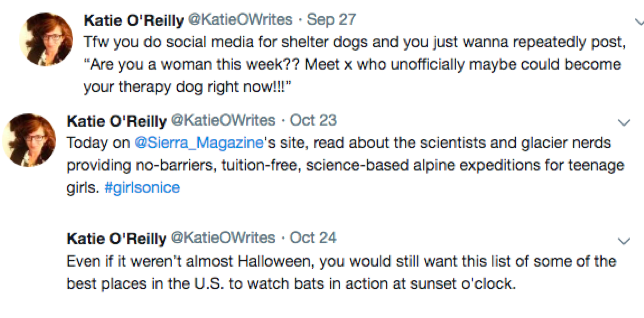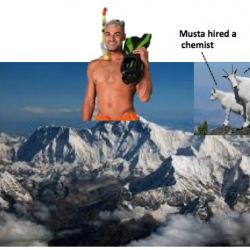Let's have a multiple choice test.
If you want to climb Everest you should:
a) Hire a Sherpa
b) Hire a chemistry tutor
Seems pretty obvious, no? I mean, wouldn't you want to rely on someone who knew something about mountain climbing? Conversely, if you wanted to write an article about chemistry would you hire someone who knows about mountain climbing but not chemistry?
The answers may seem obvious and logical, but neither logic nor knowledge seem to mean much to the Sierra Club or its adventure and lifestyle editor Katie O'Reilly. Otherwise, why would O'Reilly be writing an article about cancer-causing chemicals?

Katie O'Reilly is Sierra's adventure and lifestyle editor. Follow her on Twitter @katieowrites.
Since she was kind enough to provide a Twitter handle, let's take a look at some of her recent tweets:
Hmm. Shelter dogs, teenage girl glacier climbers, and bat watching. Doesn't seem to be a whole lot of chemistry or toxicology in there but let's give her a break. Maybe O'Reilly has hidden credentials which enable her to understand these concepts but just hasn't tweeted about them lately. Maybe this shows up in the Sierra article.
No.
The article contains a bonanza of anti-scientific garbage. A very high mountain of it. Shall we climb to the summit and check out the view?
I recently wrote how the FDA should be ashamed of itself for bowing to pressure from a coalition of "environmental" groups (1) and instituting a policy that is so atrociously antiscientific that a sophomore organic 101 student would be shaking his/her head in disbelief. (See FDA Food Additive Ban Is Unscientific And Irrational). O'Reilly's article is little more than a synopsis of the FDA decision with input from additional "experts."
"Just in time to lend Halloween festivities a bitter twist, the Food and Drug Administration earlier this month banned seven artificial additives widely used to flavor processed foods including candies, baked goods, booze, soda, and gum... the flavors were causing cancer in laboratory animals...[The move to get these seven chemicals banned] all started with a first-of-its-kind 2016 petition and resulting lawsuit from a coalition of public health and environmental groups.
Katie O'Reilly, Sierra's adventure and lifestyle editor.
It should not be the least bit surprising that the groups that pressured the FDA are the same bunch of chemophobes (minus the chemistry) that make a very decent living ensuring that Americans live in constant fear of chemicals, regardless if they are harmful, harmless, or somewhere in between. And who might these folks be?

Photo: Pomona.edu
"...the Center for Food Safety, Center for Environmental Health, Center for Science in the Public Interest, Breast Cancer Prevention Partners, Earthjustice, Environmental Defense Fund, Environmental Working Group.."
Shocking.
If O'Reilly's chemistry background isn't up to snuff, the experts she consults are just as bad, maybe worse.
“There’s something so beautiful, so simple about this rule. If tests show that something causes cancer, then don’t put it in our food.”
Caroline Cox, senior scientist with the Center for Environmental Health
Cox has a master’s degree in entomology from Oregon State University. Bugs.
The newly prohibited synthetic compounds—benzophenone, ethyl acrylate, eugenyl methyl ether, myrcene, pulegone, pyridine, and styrene—are used to help mimic natural flavors like mint, cinnamon, and garlic. What’s most scary about them is that you can’t simply memorize this list and scan food labels for those additives.
The good news is that you don't have to. You are already eating them because they occur naturally in food. All seven. Most are found in numbers of fruits, vegetables, or herbs. I am showing only one example of food for each chemical.
- Benzophenone - grapes
- Ethyl acrylate - raspberries
- Eugenyl methyl ether - apples
- Myrcene - parsley
- Pulegone - spearmint
- Pyridine - coffee
- Styrene - cranberries
Artificial flavors are not a natural source of nutrition, and therefore they do not react with the body in the same way that other nutrients do.
Caleb Backe, a wellness expert with Maple Holistics
Maple Holistics sells a bunch of stuff for your hair. Backe has absolutely no idea what he is talking about. Perhaps his credentials are in error, possibly a result of a misspelling?
Caleb Backe, a Sellness expert.
Maybe that's it. Either way, he fails to recognize that the chemicals in the apple or those ether extracted from an apple or synthesized in a lab are identical in every way. If the chemicals are carcinogenic then so are the foods that naturally contain them (1).
Why do food manufacturers use so many artificial flavors? Backe explains that breaking flavors down into their chemical components is cheaper than sourcing the real thing.
Backe doesn't seem to be all that well versed in economics either. Let's test this out by playing...


If you're a food manufacturer and want to add more of a flavor chemical which is already in the food, it doesn't make a whole lot of sense to buy a bottle of X for $25 when you could buy a different bottle containing the exact same X for $15. The only difference between the bottles is $10. Backe wants you to buy the $25 bottle. Doesn't make a whole lot of sense, right? (3).
“Consumers’ awareness is increasing all the time, and this is just part of that larger trend... More and more, I think people just want real food.”
Caroline Cox
I'm going to have to disagree with this. I think what people want is real information. 
Photos: Business Insider, Wikipedia
NOTES:
(1) Has anyone wondered why environmental groups are sticking their noses into trace chemicals in foods or the containers they come in? Assuming that there is any real issue here (there isn't) it is a medical issue, not an environmental one. Yet, we see a non-stop barrage of medical scares from groups like NRDC and EWG. They know little or nothing about chemistry, toxicology, or medicine but are right in the middle of a massive effort to frighten Americans about chemicals. Why are they involved at all?
(2) Yet we coffee drinking apple and cranberry eaters still roam the earth. Because while the "big seven" may cause cancer in genetically cancer-prone rats who are fed high doses, they are found in very low quantities in the food.
(3) Except maybe if you are a Zabar's customer.

